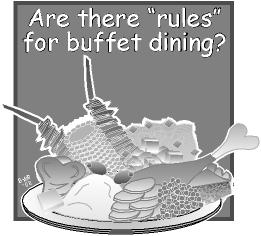
Another way that hors d’oeuvres are often served at a reception is on a buffet. Most of us have been to a buffet of one kind or another. We’re all familiar with our neighborhood ethnic buffets -- Chinese, Mexican, Italian, etc. These are usually low cost, all-you-can-eat restaurants. (I wish we could change that to, "all you choose to eat". It’s really not a contest!)
Barb is a food writer, so we’re sometimes invited to charity buffets that cost hundreds of dollars. But no matter what the price of the buffet, the rules are the same. I’m often asked if there are really rules for a buffet. Yes, there are!

Many buffets are self-serve. Start at the beginning of the line by taking a plate. Always use the serving utensil that has been provided for you and help yourself. I feel that several trips to the buffet line make more sense than taking all of your food at one time. I usually start with salads and cold offerings, then return for hot foods.
The primary rule is to not overload your plate. No one cares how often you return to the buffet (relax . . . no one’s counting), but everyone will notice a seriously overloaded plate.
Buffets -- especially those at cocktail parties -- can be tricky. You might end up with a plate in one hand and a glass in the other. It’s very difficult to eat that way. Recognizing this problem, some event organizers now provide guests with plates that are specially designed with a notch cut out to hold the stem of a wineglass. There are also "plate clips" that serve the same purpose.
When none of these handy gadgets is available, find yourself a corner of a table, set your drink down and enjoy your food. Sometimes areas are set up for you to sit and eat or stand at waist-high tables.
We’ve all gotten good at cleaning up after ourselves. This is one of the positive by-products of fast food restaurants. When you’re finished eating at a formal affair, though, you really don’t have to clean up after yourself. Just leave your glass and plate; a server will remove them. Sometimes there will be trays set up for you to place your used dishes, glasses, napkins and other items (like the toothpicks or skewers that are sometimes used with hors d’oeuvres). You’ve probably seen people leave glasses on the floor or deposit their toothpicks and napkins in the nearest plant pot. This is not where they belong!
There are reasons you might want to return to the buffet table. You missed something the first time through or you just want some more of something that you really enjoyed. Always take a fresh plate for your next trip.
If you have a cold, you’ve left your germs on the plate you’ve used. Plates, silverware, glassware are all good conductors of germs. If you reuse your plate and the serving spoon makes contact with it, your germs spread to the serving spoon. Once the spoon goes back into the serving dish, you’ve contaminated the food. Always take a fresh plate.
Now, here’s a tough one. I know, because it’s hard for me. Don't eat while you’re going through the buffet line! We like to go to Las Vegas. At casino buffets, five thousand people might be served during one meal period. Sometimes it feels like it might be days before you’re able to sit down and eat. Try to be patient. Don’t nibble while in line.
We’ve all seen this: A young person helps himself to crudités (cut up veggies) and dip. He takes a carrot, dips it in the Ranch dressing, takes a bite, dips it again. What’s that called? Double dipping! He’s now contaminated that dip for everyone who follows him in line.
Of course, the obvious way around this is to place some veggies on your plate, add some dip using the spoon provided and, once you’re situated, you can dip to your heart’s content ? it’s on your plate. (You’ll find more on double dipping in the "entertaining at home" section.)
Buffets are organized to minimize lines. There can be a variety of stations: cold line, hot line, meat carving, salads, omelets, etc. You can go from station to station with the same plate ? as long as you haven’t eaten from it. Once you’ve eaten from your plate, you have to get a fresh one.
So much for the cocktail party. At this point, let’s say that everyone adjourns to the chapel for the actual wedding ceremony.
RETURN TO MAIN COURSE ON DINING ETIQUETTE INFO AND ORDERING PAGE